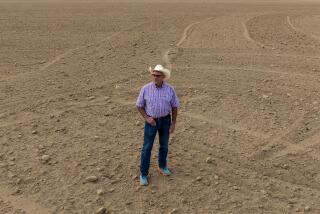Retrenchment by Major Cotton Firm Jolts Small Town Rooted in Farming
- Share via
CORCORAN, Calif. — This is a season of hard decisions for employees of the J. G. Boswell Co., a California agricultural colossus that for decades has enjoyed all the prosperity and power attendant on its position as one of the nation’s largest producers of cotton.
Nearly two-thirds of Boswell’s 900 workers--field hands, foremen and office-bound executives alike--have received letters presenting an unusual incentive program. It is intended to entice older employees into early retirement and encourage younger ones to find work elsewhere.
“Our company has been in the farming business since 1925,” wrote J. G. Boswell II, chairman of the board and nephew of Col. J. G. Boswell, the company’s founder. “We have enjoyed some very good years and have weathered several bad times. A great deal of our success has been due to the strength and dedication of our employees. . . .
“Unfortunately, the current farm situation forces us to have to again cut operations and costs. This means there will have to be significant reductions in payroll.”
Boswell’s letter startled the many people who thought that California’s style of large-scale corporate agriculture could withstand the pressures facing small family farms across the country, and it buttressed the already inevitable conclusion that this little San Joaquin Valley town, and others like it, cannot survive relying solely on agriculture.
Company officials have sought to present the so-called “voluntary early retirement and separation program” as a bold initial step in a restructuring designed to make the farming operation leaner and more profitable.
They have stressed that all workers have the option of staying--a gamble against the possibility of being laid off or demoted after Dec. 31, when the incentive offer expires--and describe the incentives as quite lucrative. “Some people are leaving here with their pockets lined with gold,” said William A. Case, personnel manager.
Finally, the officials have emphasized that the company is in no danger of folding and in fact continues to turn profits. “The health of the corporation is very good,” said John Sterling, general counsel.
Concern About Future
Nonetheless, Sterling and others said profit margins have dropped, corresponding with the price of cotton, which is about half of what it was in the peak years of the 1970s and is falling. Concern about the near future is what prompted Boswell to act, they said. The company blames an array of culprits, some of them familiar figures in the national farm crisis saga.
“There has been a lot of attention in the Midwest about the plight of the small farmers,” Case said. “The fact is, those problems are here in the West, too. We are not just fat, happy and coasting.”
Washington is blamed for subsidy programs that encourage smaller growers to keep planting cotton despite surpluses that cut prices. The strength of the dollar overseas is blamed for undermining export potential. And lastly, there is China’s growing cotton crop, which Boswell officials said has the potential of significantly adding to what is already a worldwide surplus of cotton.
Boswell officials said China’s cotton production leaped in one year from 7 million bales to 23 million bales--”and they pick it all by hand,” said one awed executive. (By comparison, the United States produces about 13 million bales of cotton a year, 200,000 of which are grown by Boswell.)
Despite the bleak cotton forecast, Boswell officials said there is no intention to switch to other crops in any significant degree. It is cotton that made the company, and it is cotton that the company knows best how to grow. Cotton also is the crop most suitable for the company’s 140,000 extraordinarily well-tended acres that, in this season, lay dark and rich, the crop picked clean, and ready for a final winter plowing.
The Boswells farm the Tulare Lake basin. As the name implies, the vast region is naturally a body of water fed by several Sierra rivers. But with dams and levies, plows and political clout, the Boswells and other big farmers here have managed in this century to transform the basin into fertile farm land. And with the farms have come the small towns such as Corcoran, which had 1,000 inhabitants when it was incorporated in 1914 and now, 71 years later, has grown to 10,000.
Nature’s surrender of the basin has not been unconditional. Every 10 years or so, the rivers flood and the basin begins to fill. The latest flood was in late 1982 and it was a bad one. In the two years it took to reclaim the basin, Corcoran’s economy suffered. Unemployment rose to more than 30%, the housing market was shot, and taxable sales dropped from $65 million a year to about $40 million, according to City Manager George T. Lambert.
‘Band-Aided Things’
“We kind of limped along through it,” Lambert said, “and kind of Band-Aided things together.”
The flood, coupled with the already-declining fortunes of the national farm economy, convinced city officials to push forward hard to find ways to diversify the Corcoran economy. An industrial park was dedicated, revitalization committees were formed, and light industries were courted.
So far, two small manufacturers have agreed to move their operations here. But the biggest coup has been the town’s successful lobbying for a state prison. Construction of a correctional facility that could employ as many as 1,200 people is expected to begin in a little more than a year.
With the Boswell announcement, those who pushed hard for the prison and industrial park are being heralded as visionaries. Lambert said he has been contacted by colleagues at other small farming towns asking how Corcoran has managed its successful courtship of light industry.
In the city manager’s view, farm towns that refuse to evolve and diversify face extinction.
‘Depression-Level Prices’
“The bottom is falling out,” he said. “What we are experiencing is Depression-level prices and difficulty in farming to make ends meet. So smaller communities dependent on farming have to watch out. They have to diversify. Not that we want to supplant farming, but we have to take up the slack.”
While the prospect of a prison provides a source of hope, the reality is that it will not contribute to Corcoran’s economy for at least a year, and there is concern in the community about what the short-term impact of the Boswell restructuring will be.
No one expects an immediate exodus, especially by older Boswell hands who take early retirement. Younger professionals who seek careers elsewhere are more likely to move away.
For merchants, the Boswell announcement has added an element of uncertainty to what should be their busiest season of the year. Many were banking on this Christmas rush to help overcome the lingering effects of the flood.
‘Trying to Break Even’
“Right now,” said 78-year-old Ray Mustain, who has owned a pharmacy here for half a century, “as far as I can see, most of the merchants are just trying to break even. That’s the condition we are in, and I don’t see any change now until next year.”
Mustain can recall better times. “When I first came here we had all the cotton pickers,” he said standing among toy displays set out in anticipation of Christmas shoppers. He recalled that as many as 25,000 workers would fill the town throughout harvest season. “During the cotton season, you couldn’t even walk down Main Street. It was filled with people. There was a time when we used to say that, ‘Here in Corcoran, we have a millionaire on every corner.’ ”
Last week, red, green and gold bunting was hung across the town’s busiest street as Christmas decorations. In some stores, workers could be seen dressing the windows with seasonal displays. Nonetheless, some merchants fear that shoppers will be more conservative as a result of the Boswell program. Interestingly, others expect just the opposite, anticipating freshly departed workers with big severance pay checks to spend.
So far, about 100 employees have agreed either to early retirement or the severance incentive. There are several formulas for severance pay, most depending on age and length of service.
Playing Waiting Game
Company officials expect that there will be a rush of departures as the Dec. 31 expiration date nears. They said some office strategists appear to be playing a waiting game, attempting to determine whether their superiors or rivals are leaving, and thus creating promotional opportunities.
While steadfastly refusing to say how many workers the company needs to lose in order to restructure, Boswell officials have said that they would like to reduce the $33-million-a-year payroll by 10% to 20%. They said they do not want to announce any goals so as not to influence workers in their decisions.
More to Read
Inside the business of entertainment
The Wide Shot brings you news, analysis and insights on everything from streaming wars to production — and what it all means for the future.
You may occasionally receive promotional content from the Los Angeles Times.











